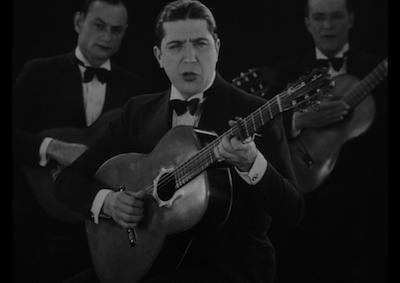Note: this double feature also screens Nov. 11 at the Downtown Independent.
Restored by Fundación Cinemateca Argentina
El día que me quieras (U.S., 1935)
Before his tragic death in an airplane accident, the legendary Argentine singer Carlos Gardel starred in several American-made Spanish-language features that, in addition to contributing to the popularity of sound films in Argentina, were extremely successful across Europe and Latin America. Released in July 1935, a few weeks after the singer’s death, El día que me quieras was an international hit. Produced by Gardel’s own company, Éxito Productions, and distributed by Paramount, the film narrates the vicissitudes of a singer who marries a dancer against his father’s wishes. Although screenwriter Alfredo Le Pera was not satisfied with some of John Reinhardt’s directorial choices, nor with the film’s final cut, many consider it Gardel’s greatest film, including the singer himself, who, five days before his death, wrote to his agent: “I still think that it is my best work in films, and that we have topped everything with its songs.” —Roberto Esteban Green Quintana
Antes de fallecer trágicamente en un accidente de avión, el mítico cantante argentino Carlos Gardel protagonizó varias películas norteamericanas en español que, además de popularizar el cine sonoro en Argentina, fueron muy exitosas en Europa y Latinoamérica. El día que me quieras, estrenada en julio de 1935 a las pocas semanas del fallecimiento del cantante, fue un éxito internacional. Producida por la compañía de Gardel, Éxito Productions, y distribuida por Paramount, la película narra las vicisitudes de un cantante que se casa con una bailarina en contra de los deseos de su padre. Aunque el guionista y letrista de la película, Alfredo Le Pera, no quedó satisfecho con algunas de las decisiones tomadas por el director, John Reindhardt, ni con el montaje final, muchos consideran El día que me quieras la mejor película de Gardel, incluido el propio cantante que, cinco días antes de fallecer, escribió a su agente: “Sigo creyendo que es mi mejor trabajo cinematográfico y que hemos matado el punto con las canciones.” (trans. Roberto Green)
DCP, b/w, 82 min. In Spanish with English subtitles. Production: Éxito Productions. Director: John Reinhardt. Screenwriter: Alfredo Le Pera. Cinematographer: William Miller. Cast: Carlos Gardel, Rosita Moreno, Tito Lusiardo, Manuel Peluffo.
Así cantaba Carlos Gardel (Argentina, 1935)
Before signing his first contract with Paramount in 1931, Carlos Gardel starred in 10 shorts considered by several film historians to be the first Argentinian sound-on-film productions. Filmed between October 23 and November 3, 1930, each of these simple shorts feature the performer, accompanied by either his guitarists or Francisco Canaro’s orchestra, singing one of his songs. However, the crew faced numerous problems during filming: the camera turned out to be too noisy and a booth had to be rapidly made to isolate it, thus impeding camera mobility. Also, due to the set’s limitations, cinematographer Antonio Merayo was forced to flood it with light, making the temperature almost unbearable. But probably the worst incident occurred when five of the 15 shorts originally filmed were destroyed by the lab during processing. The remaining shorts were shown in cinemas prior to the main feature, and, after the singer’s death, were compiled under the title Así cantaba Carlos Gardel. —Roberto Esteban Green Quintana
Antes de firmar su primer contrato con Paramount en 1931, Carlos Gardel actuó en diez cortometrajes que varios historiadores consideran las primeras producciones argentinas que exitosamente utilizaron la tecnología de banda de sonido incorporada. Rodados entre el 23 de octubre y el 3 de noviembre de 1930, en cada uno de estos sencillos cortometrajes Gardel interpreta una de sus canciones acompañado por sus guitarristas o por la orquesta de Francisco Canaro. CNo obstante, el rodaje no fue sencillo: la cámara resultó ser demasiado ruidosa y fue necesario construir una cabina para aislarla, lo que limitó su movilidad. CIgualmente, debido a las limitaciones de los decorados, el director de fotografía, Antonio Merayo, se vio obligado a inundar el set de luz, haciendo que la temperatura fuese casi inaguantable. CPero, posiblemente, el mayor incidente fue la pérdida de cinco de los quince cortometrajes inicialmente rodados cuando fueron procesados en el laboratorio. CLos diez restantes se exhibieron en cines como acompañamiento a la película principal, y fueron recopilados bajo el título Así cantaba Carlos Gardel tras el fallecimiento del cantante. (trans. Roberto Green)
DCP, b/w, 35 min. In Spanish with English subtitles. Production: Cinematográfica Valle. Director: Eduardo Morera. Producer: Federico Valle. Cinematographer: Antonio Merayo. Cast: Carlos Gardel, Inés Murray, César Fiaschi, Francisco Canaro, Arturo de Nava.






 Mobile Navigation
Mobile Navigation

